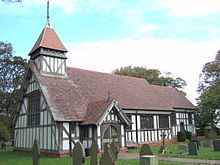St Michael and All Angels Church, Altcar
| St Michael and All Angels Church, Altcar | |
|---|---|

Church from the southwest
|
|
| Coordinates: 53°33′03″N 3°01′42″W / 53.5509°N 3.0283°W | |
| OS grid reference | SD 320,065 |
| Location | Great Altcar, West Lancashire |
| Country | England |
| Denomination | Anglican |
| Churchmanship | Central |
| History | |
| Founder(s) | William Molyneux, 4th Earl of Sefton |
| Dedication | St Michael and All Angels |
| Architecture | |
| Status | Parish church |
| Functional status | Active |
| Heritage designation | Grade II* |
| Designated | 11 October 1968 |
| Architect(s) | John Douglas |
| Architectural type | Church |
| Groundbreaking | 1878 |
| Completed | 1879 |
| Specifications | |
| Materials | Timber framed, red tile roof |
| Administration | |
| Parish | Altcar |
| Deanery | Sefton |
| Archdeaconry | Liverpool |
| Diocese | Liverpool |
| Province | York |
St Michael and All Angels Church stands to the west of the village of Great Altcar, West Lancashire, England. The church is timber-framed and is recorded in the National Heritage List for England as a designated Grade II* listed building. It is an active Anglican parish church in the diocese of Liverpool, the archdeaconry of Liverpool and the deanery of Sefton. Its benefice is combined with that of St Stephen's, Hightown. In the Buildings of England series it is described as "an utterly charming church".
The earliest record of a church or chapel on the site is in a lease dated 1429. In the 17th century the church is said to have been of timber and plaster. In the 1740s it was destroyed by fire and a new church was consecrated in 1747. This was said to have been a small brick building with a cupola containing one bell and a very plain interior. That church was demolished and the present church was built in 1878–79 to a design by John Douglas at the expense of the 4th Earl of Sefton. The church was restored in the 1990s, mainly to deal with rot which was affecting the timber.
The church is half-timbered on a brick plinth with a red tile roof. The framing is mostly close studding with a middle rail. It has been suggested that timber framing was used, not only for aesthetic reasons, but also because the foundations on underlying peat were not sufficiently stable for a stone building. The plan of the church consists of a five-bay nave, a bell turret on the west gable end, a south porch, a narrow north aisle, a two-bay chancel at a lower level, a north organ chamber, and a vestry. The bell turret is close-studded and has a pyramidal roof with a finial and a weather vane. The church is unique in Douglas' output as being entirely half-timbered.
...
Wikipedia

